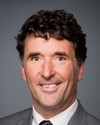Mr. Speaker, I should ask a rhetorical question here, but the first question is, where is the bill coming from? That is important to establish in order to help us answer some of the questions that will come up as we look into this bill.
The bill is not coming from Elections Canada. I have had the pleasure of a briefing from officials at Elections Canada, at my request, and it is quite clear that this bill emanates from the body politic, the government, and not from Elections Canada. That, I believe, is significant in the sense that the government therefore must answer the question that has already been put by my colleague as to whether or not this meets the charter test, whether the government has sought and obtained assurances that the proposed legislation in Bill C-6 does indeed meet the test of the charter. I believe that we might be surprised with that down the road, should Parliament decide to go much further with this legislation, because I am not convinced that it does meet the charter test.
I was also hoping to garner enough support in the House from members where there is goodwill to try to refer this bill to committee before second reading and therefore give ourselves more latitude in looking at the situation.
The representative of the Bloc Québécois who spoke said that his party would certainly consider that favourably. The member for Ottawa Centre indicated he thought the idea had merit and he would seek some direction from his own caucus.
I was hoping that if indeed the three opposition parties are in agreement here, the government would take that into consideration and would allow this bill to proceed to committee before second reading and therefore give our members who are representing each party there more latitude in dealing with a very difficult, complex and delicate situation.
I want to review how it is that Canadians can vote. There are different ways.
First, of course, they can show up at a polling station, and while at the polling station there are three different ways that Canadians can signify who they are and obtain a ballot.
The first way, as we mentioned, is by providing some sort of photo ID issued by government, one of which is a driver's licence. Another could be a passport. Another could be, in some jurisdictions, a health card. However, let it be known that 20% of Canadians do not have a driver's licence and do not necessarily have photo ID with them. Therefore, in its wisdom, Parliament, when it enacted this act in the past, recognized we had to have some flexibility for other ways of self-identification, because facial identification is not accessible to everyone.
The second way that any Canadian who is on the list of electors can use to obtain a ballot and vote is by providing non-photo ID that recognizes who they are and where they live. There is, I believe, a list of 50 or so such possibilities that they can use to identify themselves, not visually, not facially, not with a photo ID, but identify who they are and obtain a ballot.
The third way is go to the polling station, swear a note and be vouched for by another registered elector. All the person needs to provide is his or her name, address and signature. Again the person does not need to provide any photo ID.
There is a fourth way people can vote, which is really broken down into two. Both are called special ballots.
One of those two other ways is a mail-in ballot. At the start of or during a campaign, electors can ask that their ballots be sent to them and they can mail them in. It is usually people from overseas who will do that, but I have known citizens in the riding of Ottawa--Vanier who have exercised their right to vote by mail-in ballot. In those circumstances, they do not need to provide photo ID as well.
The other way is to obtain a special ballot from the returning officer of the riding. People do not even have to show up in person. Someone else can go to the returning officer's office up to six days before the actual polling day, obtain a ballot and go back to the person for whom they are doing that. The person, however, must sign and put the ballot in the sealed envelope and then return it by a specified time.
Essentially, we have created an environment where Canadians have five ways of voting and that is done to ensure Canadians can vote. Of those five ways, only one requires facial identification. The other four do not. That is how it is now and that is how it would remain should Bill C-6 be adopted. It is important that we take that into consideration.
Then we get into what Bill C-6 really does and we heard what it does tonight. It basically forces one very small, narrow category of Canadian citizens to unveil themselves should they be veiled for religious reasons.
Here is where I have a real problem. We have a situation where a Muslim woman, who has decided for religious reasons to wear a veil, goes into a polling station on election day, is forced to remove her veil and yet is not forced to facially identify. She can present two pieces of identification that recognize her name and her address or swear an oath and will not need to present photo ID.
What are we doing here? When my colleague from Ottawa Centre says that we have a solution looking for a problem, I would perhaps add a word to that. It is perhaps a non-solution looking for a problem because we are not changing anything here. However, we are going to force Muslim women to unveil themselves without having them photo identified. What is the point? That is a question that deserves an answer.
I do not have a problem with demanding that Muslim women identify visually. We do so as we do for every Canadian. If we want a passport we must have our picture taken and it must be in our passport. I do not have a problem with that and I do not think Canadians have a problem with that.
If we want a driver's licence, I believe in all jurisdictions in this country, we must have a photo. I know in Ontario we must have a photo if we want a driver's licence, and an unveiled photo if one happens to be a Muslim woman. I do not have a problem with that.
If we want to board a plane in this country we must provide photo ID, unveiled, and we must prove who we are as well. I do not have difficulty with that and I do not think anyone has. It is the same thing for the citizenship card. People must have a photo on it and Muslim women must be unveiled. I do not think anyone has difficulty with that because it is a universal application.
We have a situation here where we have said to all Canadians that they have five different ways of voting but for Muslim women we will be adding a special condition: they must remove their veil. At the same time, we are telling them that they do not need to provide facial proof of who they are. What is the point? That brings us to the questions of charter compliance. We heard comments about that earlier today.
We have had discussions concerning individual rights versus collective rights, and concerning freedom of religion and religious rights in relation to the fundamental right to vote. That is certainly the kind of debate that should take place in a House of Commons or Parliament. I am very interested in this question, and so are most of my hon. colleagues.
However, if the government were to ask me to express my opinion beforehand, without even knowing whether the bill before us meets the requirements of the Charter of Rights and Freedoms, if the government were to ask me to state my position before I even had some answers to some of these questions, in my opinion, the government is going too far, too fast.
This bill involves potential fundamental conflicts between freedom of religion and the right to vote. This must be reconciled and it is up to Parliament to do so. Perhaps we will not be able to do so in this House. Furthermore, I find it rather ironic that, earlier, my hon. colleague from Ottawa Centre, who advocates abolishing the Senate, referred to that very chamber, in order to correct what he saw as a flaw in another bill, that is, Bill C-31, regarding the Canada Elections Act. We could very easily find ourselves in the same situation again.
I find it even more ironic that his party advocates abolishing the house that could in fact help us resolve this matter, if the government does not seem inclined to act appropriately, transparently and respectfully.
I want to use a very personal event. I was not sure I should but I will. I am thinking that what we are confronted with is very similar to an event, which the House may recall, that I was confronted with. In Ottawa at one point we had the merger of hospitals. The board, in its wisdom, hired someone who it believed to be the most competent person to help it navigate through the merger of a number of hospitals.
The board hired a gentleman who had essentially shepherded hospitals in the Montreal area in the same kind of environment, which is very difficult. People are suffering through a great deal of uncertainty. There are all kinds of questions. There may be people who fear for their jobs. Therefore, it is a tense environment to start with.
This gentleman happened to be David Levine who had been in the past a Parti Québécois candidate in the riding of D'Arcy McGee. He garnered, I gather, a very low number of votes, but that is neither here nor there.
However, we were confronted with a situation where a gentleman who had been hired was being threatened of being fired for political beliefs although he had accepted squarely to leave whatever political beliefs he held at the door. They were not germane to the job he was hired to do. It was a very heated debate in our community, so much so that the board thought it should hold a special meeting and it did. It chose the biggest hall it had at the hospital and still people spilled over to the street.
I chose to go and speak. Some of my friends told me that I was nuts and that I would be confronted. It was a bit mobbish but I felt it was important that the principle in this country that we do not hire and fire people based on their political beliefs if they leave those beliefs at the door. If we are hiring people for their competence and for their capacity, that is what they should be judged on, not because they may have run for a political party that we do not agree with.
I certainly have never shared the views of the Parti Québécois in terms of its basic tenet or the Bloc for that matter, but we cannot fire people. That was the slipperiest slope we could get on.
I have the feeling that the bill that is before us has such elements because of a rather volatile reaction to Mr. Myrand's decision to apply the law as he chose to. In the rush to condemn or criticize, perhaps some people have forgotten but what is at play here is the fundamental right of freedom of religion and the fundamental right of freedom to vote and people should be treated the same.
I know people tell me that all they are asking for is that all people who come to vote unveil themselves if they happen to wear a veil.
That is not quite true. One can vote by correspondence, vote by mail where one does not ever have to identify oneself visually. It is not quite true because one can vote by special ballot where someone else gets the ballot for the person and brings it back to the returning officer's office, so one ever needs to visually identity.
It is not quite true because right now someone else could show up and not have to prove who they are with visual identification, even the Muslim women whose veils we have forced them to remove because there are two other provisions that allow people to vote in this country without facial identification.
Do we want to go to that? Perhaps the country needs to look at that. I, too, have observed elections. I was in the Congo.
Last summer, I was in the Democratic Republic of the Congo, where I noticed that something that contributed to the legitimate success of the electoral process was the voter's photo ID card. Everyone had one, so it was easy. Voters also had to dip their thumb in indelible ink. There were mechanisms to make sure the vote was legitimate, that people voted only once and that the person who was voting was the person on the voter's list. Do we want to move toward that sort of system? Perhaps. In my opinion, there is some merit to it.
However, we have to recognize that today, in Canada, we do not have a universal photo ID card. Moreover, 20% of Canadians do not have a driver's licence, and an even larger percentage do not have a passport.
Two jurisdictions have a photo on their health cards. The process is still under way in Ontario, but in some provinces, people do not have their photo on their health card. In addition, they do not have their address on their citizenship card or their photo on their social insurance card. Canadians therefore have no photo ID card they can use to exercise their right to vote. That is why voters are not required to visually identify themselves by showing a photo of their face.
Why require people to uncover their face when they are not required to identify themselves in this way? It is strikingly incongruous. We are entitled to ask what is behind this bill.
What motivates a government—because the bill comes from the government and not Elections Canada—to target a group and tell the members of that group that the government no longer believes in their right to religious freedom and is requiring women to uncover their faces?
The government can impose that requirement. I comply with that requirement for passports, for boarding planes and the like. However, there is an inconsistency. When we take a plane, we have to prove our identity. If we do not, we do not board. If we want a passport, we have to identify ourselves with our face uncovered or we do not get a passport. As far as voting is concerned, we are forcing these women to show their faces, but visual identification is not required. This is does not make sense. This is totally illogical. We are not being consistent.
I hope we will take a serious look at this bill because it was thrust into the heat of a possibly non-existent crisis. As the hon. member for Ottawa Centre said, it is a solution looking for a problem; in my opinion, it is a non-solution looking for a non-problem.
As legislators of a country like Canada, which espouses human rights and has a Charter of Rights and Freedoms, we have to be consistent and respect our social foundations, which are the envy of the entire world.
If we are inconsistent we will destroy those foundations and those rights. We must be very, very careful because the bill before us is inconsistent with those rights, it is inconsistent with the purpose of the Canada Elections Act. There is a lot to think about.
I may have used up all my time, but it was important to raise these arguments and questions. I know that I am not the only one who has these questions. We have seen these questions raised in the media. Good for them. We have seen that concerns have been raised within the targeted group. I think we need to pay attention to those concerns.






